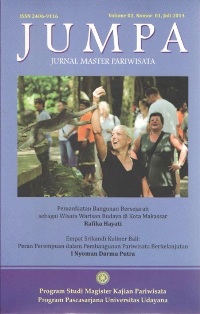ANALISIS KONSEP TRI HITA KARANA PADA DAYA TARIK WARISAN BUDAYA: STUDI KASUS PURI AGUNG KARANGASEM, BALI
Abstract
This article discusses how local wisdom, namely Tri Hita Karana (three cause of harmony and prosperity), can support sustainable tourism, such as in cultural tourism attraction of Puri Agung Karangasem, Bali. This Puri (palace) has a great potency to become a cultural tourism product an can be developed with considerable community involvement.
The Puri has selected Tri Hita Karana concept as the basis of tourist attraction’s management by giving specific attention to the three elements of Tri Hita Karana including parahyangan (spiritual/culture), pawongan (community), and palemahan (environment). Data for this study was collected through interview method to find description of the implementation of the concept of Tri Hita Karana in managing Puri Agung Karangasem as tourist attraction. Hereinafter, informants involved are the Puri’s management, local community and experts associated with Tri Hita Karana or sustainable tourism. These data were combined with secondary data such as reports or literature related with the object of research and presented in the form of description. This study concludes that the implementation of Tri Hita Karana in Puri Agung Karangasem have positive impact on all aspects involved in tourism activities, such as community, local culture and environment. These aspects are also considered as an important factor and attraction for both domestic and international tourists.














